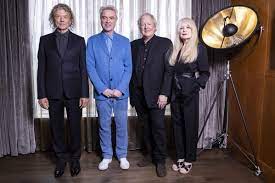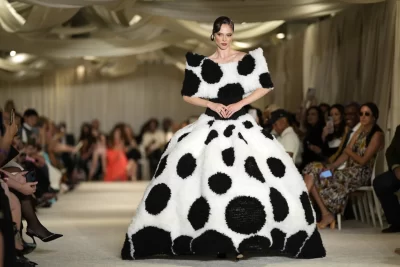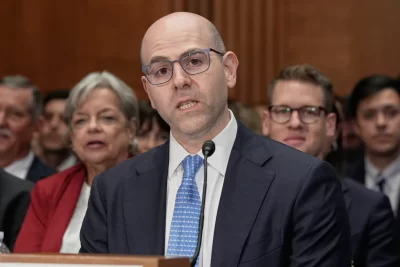
You may find yourself in a movie theater with “Stop Making Sense” playing and the members of Talking Heads in the audience.
That was the once-in-a-lifetime scenario when the new 4K restoration of “Stop Making Sense” premiered recently at the Toronto International Film Festival. On screen was a young, elastic David Byrne. In the theater, he was dancing, too, along with a crowd who couldn’t stay seated for “Burning Down the House.”
“For a moment I thought, ‘Is it OK for me to get up and dance at our own movie?” Byrne says, laughing, the morning after. “But how could you not?”
For nearly four decades, “Stop Making Sense,” directed by Jonathan Demme, has exerted an inexorable pull on all who encounter the frenetic fever of arguably the finest concert film ever made. Its power to bring together — it opens with Byrne alone on a spare stage and swells into an art-funk spectacular — is such that it’s even managed to reunite the Talking Heads, too.
For the first time in 21 years, the Talking Heads are a band again, even if only in movie theaters. Byrne, the band’s principal songwriter and singer, keyboardist-guitarist Jerry Harrison, bassist Tina Weymouth and drummer Chris Frantz — who last gathered together in 2002 for their induction to the Rock & Roll Hall of Fame — have assembled once more for the rerelease of “Stop Making Sense.”
“It feels normal,” says Weymouth. “I mean, this is our tour. We’re touring this movie.”
Since they officially broke up in 1991, the four members of Talking Heads have often squabbled, bitterly. Byrne has said he regrets his role in the band’s “ugly” dissolution. Frantz, who’s married to Weymouth, published a 2020 memoir that described some of the discord and lingering hurts. When Byrne mounted the acclaimed Broadway show “American Utopia” a few years ago, featuring many Talking Heads songs, Frantz was stung not to even be invited.
As the group congregated the morning after the “Stop Making Sense” premiere for an interview, though, they were cordial with each other. They’re now all in their early ‘70s. “How you livin’, Jerry?” greeted Frantz. Byrne gazed out the window, contemplating a possible cycling route for the afternoon. He and Harrison sat on one couch, Weymouth and Frantz on another.
Their spirits were high. The film remains in light, a potent reminder of Talking Heads’ uniquely transfixing power. Harrison helped oversee the restoration from the long-lost original negatives. It opens on IMAX screens Friday and in other theaters Sept. 29.
“One of the things that happened to me in rewatching it and working on it, was realizing: ‘Oh my God is everybody good,’” says Harrison.
“I didn’t know I was cute,” smiled Weymouth, who nimbly bounces from one foot to the other throughout the film. “The whole band, they were so attractive, so beautiful.”
“Stop Making Sense,” filmed over four nights at Los Angeles’ Pantages Theater in 1983, hasn’t dimmed with time. “Same as it ever was,” you could say. What begins with a solitary Byrne, with an acoustic guitar and boombox, steadily accumulates as the members of the band join him, then others like Parliament-Funkadelic keyboardist Bernie Worrell and guitarist Alex Weir. This jittery, wide-eyed musician singing of psycho killers to a syncopated beat attracts a legion. His movements are malleable and constant. The music grows euphoric. This IS a party. This IS a disco.
“It’s the unbridled joyousness of the performance, which snowballs,” says Frantz. “It starts off with ‘Psycho Killer,’ which is a thing unto itself. But it snowballs into this ecstatic experience. You can see it very clearly with the band members. They’re gettin’ more and more fever.”
“They’re going to church,” adds Weymouth.
Demme , who died in 2017, once called shooting live music “the purest form of filmmaking.” And much of “Stop Making Sense,” with an eagerly responsive Demme and cinematographer Jordan Cronenweth catching all the interactions between the band, approaches a perfect harmony of sound and image.
Now THAT, Byrne said after watching the film on IMAX, is why you go to the movies.
Byrne had choregraphed the Talking Heads tour that year, for the album “Speaking in Tongues.” Their concert came ready-made for Demme, a devoted Heads fan and an ardent music listener who approached the band with producer Gary Goetzman after seeing them perform in 1983 at the Hollywood Bowl.
“The great thing about Jonathan Demme was he had this amazing enthusiasm,” says Weymouth.
For several weeks beforehand, visual consultant Sandy McLeod came along on tour to plot out how the filmmakers might document the concert. Byrne’s concept stemmed from, he says, “showing people what it takes to put on a show.”
“We start with an empty stage and gradually add each part, each musician. As they come in, you hear what their contribution is,” Byrne says. “You see how it all gets done. It’s like a magician showing how the tricks are done, but the trick still works. We’ve seen behind the curtain, but the trick still works.”
And the “tricks” are grand. There’s, of course, Byrne’s iconic, Kabuki-influenced big suit in “Girlfriend Is Better”– now even bigger in IMAX. (The big suit, itself, resides in a big box in Byrne’s office.) There’s also his achingly gentle dance with a floor lamp in “This Must Be the Place (Naïve Melody)” — a sumptuous echo to Gene Kelly’s tap dance around a lamp post in “Singin’ in the Rain.”
The lamps were made specially to be a little taller than the typical size, so they would illuminate faces.
“We bought a few of them. They’d break all the time. I’d drop them and all the light bulbs would break,” says Byrne, laughing. “We’re kind of lucky that the ones in the film held up.”
Other elements of “Stop Making Sense” have also proved remarkably resilient, though they can be harder to pin down. The songs, particularly something like “Life During Wartime,” synthesized a modern discombobulation that was only just emerging in the tech-nascent ’80s. “Stop Making Sense” — shot on film with six cameras but mixed digitally in Hal Ashby’s editing room — heralded a disorienting information age future while at the same time making the case that this strange new world could also be funky as hell.
“There’s most definitely a prescient nature in David’s lyrics,” Harrison says. “David seemed to capture, you might say, the future zeitgeist.”
That can be heard in what Byrne was singing about but it’s also embodied in his constant, live-wire physicality. It was only a few years before “Stop Making Sense,” on tour in 1980, that Byrne began to find his a stage persona.
“Before that, I didn’t move much. I just thought: It’s OK to move but you have to find your own way to do it. You can’t be imitating other performers,” he says. “So I just listened to the songs and thought: How does this groove make you move? On ‘Life During Wartime,’ I felt like running.”
Unlike most concert films, Demme elected not to cut away to the audience until the final moments of the film. He wanted to preserve the pure experience of a live concert, and not mix in interviews along the way.
“U2 wanted to make a film that was better than ‘Stop Making Sense’ and then they went and ruined it by doing all those interviews,” Weymouth says. “The art should be separate from the personalities. So you don’t get all the dysfunction.”
To her, “Stop Making Sense” derives from a different era when not everything was self-documented. It was a vividly artful presentation that left it up to the viewer to interpret, or dance to.
Talking Heads never participated in another film, though Byrne’s “American Utopia” was captured thrillingly by Spike Lee in a 2020 film. (Lee, in attendance at the Toronto premiere, pronounced “Stop Making Sense” “the GOAT” of concert films.)
The 1983 tour was the last time Talking Heads hit the road, and Byrne has consistently said he has no interest in a reunion tour. After their experience with Demme, a career-spanning documentary also seems unlikely.
“It would have to take something pretty extraordinary to make us want us to do something like that,” says Harrison. “If the right filmmaker came along and you could then imagine yourself in the framework he or she sets up, it’s possible. It certainly wouldn’t be now.”
Besides, who needs legacy burnishing when “Stop Making Sense” is still so alive? In conversation, the band again and again marveled at how deeply in tune they were with one another then — perhaps especially in contrast to the years that followed.
“This is going to sound really ridiculous but I think about the fusion of the sun,” says Weymouth. “It implodes and explodes. And I think that push and pull was so magical to our creative forces, the way that we worked together, the way we were supportive of each other. It was very special and none of us has found it again. If we sat down and played music, we’d be connecting again.”
The Talking Heads members are now, a little surreally, part of the audience gazing back at “Stop Making Sense.” It remains the defining encapsulation of what the Talking Heads were and what they achieved. If there’s one thing they can all agree on, it’s an abiding love for it.
“Having had two near-death experiences in the past couple of years – one with Tina in a head-on car crash — who’s the guy who said ‘Enjoy every sandwich’? Warren Zevon,” Frantz says. “That’s what I’m doing.”
“It’s a good legacy. Now I can die,” says Weymouth, before adding: “I don’t want to.”





